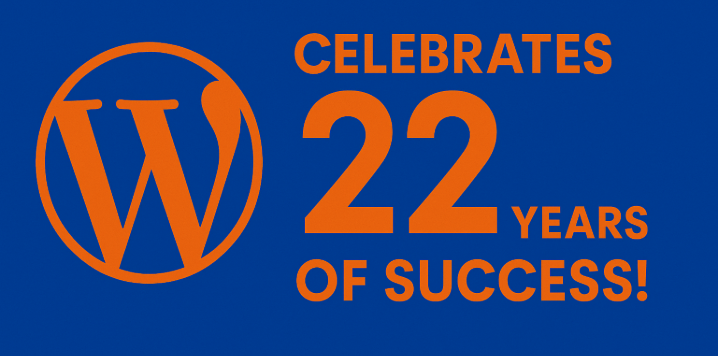WordPress celebrated its 22nd anniversary on May 27, 2025. From a simple blogging tool, WordPress has grown into a global platform powering over 43% of all websites. In today’s article, we’ll take a deep dive into the remarkable journey of WordPress, from a humble blogging platform launched in 2003 to the powerful and enterprise-level CMS it is in 2025. We’ll highlight key milestones, major feature updates, community contributions, and how WordPress has shaped the broader web development landscape.
If you have not checked my last article which is about popular PHP based CMS platforms then you can check it here.
Table of contents:
- The beginning of WordPress (2003)
- Major Milestones Over the Years
- WordPress Features
- Community and Ecosystem Growth
1 – The beginning of WordPress (2003)
WordPress is a free and open-source content management system based on PHP & MySQL. Matt Mullenweg & Mike Little released WordPress on May 27, 2003. It is a flexible CMS that can be used for different types of websites including a blogging, media galleries, a business website, a government website, online store, and online community. WordPress is available in more than 70 languages.
WordPress is a well-known fork of the b2/cafelog blogging software. Michel Valdrighi originally developed b2/cafelog, which Matt Mullenweg and Mike Little later forked to create WordPress.
2 – Major Milestones Over the Years
2.1 – 2003 – The Birth of WordPress
Matt Mullenweg and Mike Little released WordPress 0.7 as a fork of b2/cafelog. In the earlier days, it offered basic blogging features with improved code structure and flexibility.
2.2 – 2004 – Plugin Architecture
Version 1.2 “Mingus” introduced a plugin system, allowing users to extend functionality. Plugin is a piece of code which developers use to extend the WordPress core functionality.
2.3 – 2005 – Themes and Pages
WordPress version 1.5 “Strayhorn” introduced themes and static pages. A WordPress theme is a collection of files that work together to produce a graphical interface of the website. Introduction of themes and static pages marked a shift from blogging to a more flexible content platform.
2.4 – 2005 – WordPress.com Launch
Automattic launched WordPress.com, bringing WordPress to non-technical users via a hosted version.
2.5 – 2008 – New Admin Interface
WordPress 2.5 launched new admin interface to make content management more friendly and modern.
2.6 – 2010 – Custom Post Types
Version 3.0 “Thelonious” introduced custom post types, custom taxonomies, and multisite support. This version marked a huge leap toward WordPress becoming a full-fledged CMS.
2.7 – 2013 – WordPress Powers 18% of the Web
WordPress hit a major milestone in global web usage. This version demonstrated its rapid growth and popularity.
2.8 – 2018 – Gutenberg Block Editor
Version 5.0 introduced the block editor (Gutenberg). Gutenberg is a user-friendly block-based editor enables you to design your posts and pages easily. With Gutenberg, you can add multiple media types and arrange the layout within the editor using blocks.
2.9 – 2021 – Full Site Editing (FSE) begins
WordPress introduced tools for editing entire site layouts using blocks. FSE has the ability to build and customize an entire website using blocks, including elements like headers, footers, and templates.
2.10 – 2025 – 22 Years of Success
WordPress powers over 43% of all websites globally and celebrated as the most widely used and customizable open-source CMS in the world.
3 – WordPress Features
WordPress is a versatile and popular content management system (CMS) with numerous features. It offers a wide range of tools for creating and managing websites, from blogs to e-commerce sites.
- User-friendly interface
- Powerful media management
- Built-in comments
- Content organization
- Easy theme system
- Extend with plugins
- User management
- Open-source and free
- SEO friendliness
- Mobile-responsive design
- Active community
- Regular updates
- Multilingual support
- Multisite network
4 – Community and Ecosystem Growth
- WordPress is open-source software, licensed under the GPL (General Public License).
- WordPress offers 24 different contribution channels, welcoming both technical and non-technical individuals to help improve the platform.
- WordCamps are informal, community-organized conferences held around the world. Meetups are smaller local gatherings for users and developers to connect and share. These events encourage networking, learning, and contribution.
- Over 60,000 free plugins and 10,000+ themes are available in the official WordPress repository. This makes WordPress endlessly customizable for individuals, businesses, and enterprises.
- The Polyglots team has translated WordPress into over 200 languages, supporting users globally.
- Community values include collaboration, freedom, respect, and transparency. The “Five for the Future” initiative encourages organizations to dedicate 5% of their resources to WordPress development.
- The strength of WordPress doesn’t just lie in its code, but in the global community that builds, supports, and grows it every day.
Conclusion
As we explored WordPress’s key milestones, powerful features, and the vibrant community that has driven its growth over the past 22 years, one thing is clear—WordPress is more than just a CMS; it’s a global movement. Now entering its 23rd year, WordPress continues to focus on innovation, accessibility, and empowering individuals to create their own space on the web. Looking ahead, we’ll be sharing more advanced WordPress tutorials to help you get even more out of this incredible platform.
If you like this article, then you can write your words in the comments section. Or if you have query or suggestions then don’t hesitate to reach out us. Not least but last, you can also follow us on X.com.

Useful info about WordPress 22 years of journey. Thank you!